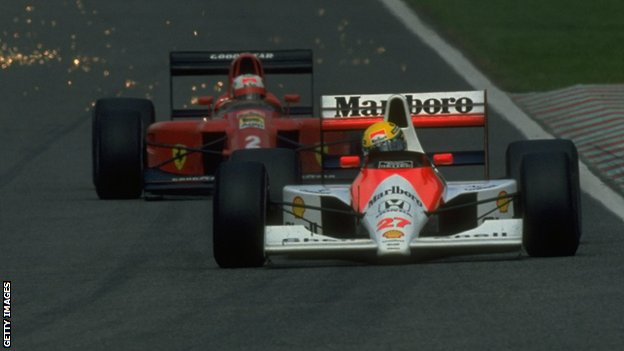What is racing? In the simplest terms, it is a contest between competitors to see who reaches the finish first.
By definition, any Formula 1 grand prix fits that description. And yet theevents of the last race in Canada, with drivers constantly advised over the radio by their teams to save fuel or brakes or tyres, have re-ignited a storm of debate about the state of the sport.
The problem was summed up in one explosive radio message in which McLaren’s Fernando Alonso refused a request to save fuel.
The drivers aren’t happy. The fans aren’t happy. The teams aren’t happy. Big changes are planned to the rules for 2017, but what exactly is wrong and how can it be fixed? And what, in fact, actually needs fixing?
Fuel and tyre conservation have always existed
The reality is that fuel and tyre conservation have always been a part of F1. It was just less obvious in the past.
Niki Lauda is an icon and F1 legend. A man who won three world titles and came close to death in a fiery accident in the 1976 German Grand Prix, from which he still bears the scars today.
But ask him if he had to worry about tyre management when he was racing and he says: “Sure. It was always different – more in some races, less in others. The difference was we did not have tyre sensors and engineers telling us how fast to drive. We had to work it out for ourselves.”
The same could be said of fellow world champions Juan Manuel Fangio, Jackie Stewart or Ayrton Senna.
So why is it being talked about more now? Is it because many of the best drivers can remember F1 when it was more fun for them?
Is it because radio conversations either did not exist or were not broadcast in the same way as they are now?
Is it simply because the sport has a higher profile than ever before, and is analysed in a way it was not, say, 20 years ago? Is the greater focus on this sort of thing a result of a season which, let’s face it, has not really lit up yet?
Drivers are not driving flat out – or are they?
The perception in hearing radio messages asking drivers to save fuel is that this is somehow ‘wrong’, that it is not F1, that it somehow diminishes what the drivers are doing.
But that belief is the result of a misunderstanding of what is actually going on.
A lighter car is a faster car, so teams are always trying to put in as little fuel as possible.
Since the end of refuelling five years ago, teams have routinely short-fuelled their cars, because it is faster to start a car with less fuel and ask a driver to economise at various points of the race than it is to fill it up with enough fuel to drive flat out to the finish.
This was less the case when refuelling was part of the rules from 1994-2009, but even then fuel-saving had a role.
In any case, just because a driver is fuel-saving does not mean he is not being tested.
Britain’s reigning world champion Lewis Hamilton is the driver who seems closest in F1 to the image of the ‘flat-out racer’, so might therefore be expected to be most against fuel saving. But he is not.
“It doesn’t annoy me at all,” he says. “It is the name of the game. When I hear it, I try to do it better than everyone else behind me. Simple as.”
Does he understand the fans’ frustrations?
“I don’t,” he says. “I would imagine people don’t understand. We are still pushing flat out but we have to use this technique of lift and coast and optimise it. It is just a different style of driving.
“If you do it wrong, you can lose too much time and lock up. It is actually easier for me to drive hot laps.”
It’s counter-intuitive, isn’t it? But fuel saving – by the technique of lift and coast – is just another aspect of a driver’s skill-set. And one that Hamilton says is “actually harder” than driving flat out.
What about the tyres?
Few people are as critical of the current F1 as former grand prix driver Mark Webber. The Australian detests the Pirelli tyres and the DRS overtaking aid, which he says together have ruined the sport.
When Pirelli entered F1 in 2011, it was on a mandate from commercial supremo Bernie Ecclestone to produce tyres that deliberately went off quickly, to promote more pit stops.
Although Pirelli has become increasingly conservative over the years, to the extent that people are now beginning to complain that the tyres are too hard, the tyres’ fundamental nature remains.
Even a hard Pirelli tyre cannot be pushed to the limit for more than a couple of laps or it will deteriorate – or degrade – too quickly and lose performance. As a result, with very few exceptions, drivers have to drive within themselves throughout grands prix.
Webber says that the fragile tyres means “drivers can get away with being 30% less fit” and that they have taken the edge off the faster corners, which test drivers’ courage less than they used to.
Many of the current drivers are of the same view, although they are more careful about expressing it.
Alonso says the last time he felt physically and mentally tested to his limit in a grand prix was 10 years ago, pointing out that cars were eight seconds a lap quicker in races in 2006 than they are now.
But ask him whether the slower racing speeds of the current cars are frustrating and he says it’s not the speed, per se, that is the problem.
Alonso says that “saving tyres and fuel from lap one is more frustrating than the pace itself – when you are so slow and you cannot have wheelspin because you overheat the tyres”.
So fix the tyres and make the cars faster?
Most of F1’s speed records were set in 2004, when refuelling meant light cars and there was tyre competition, which led to very durable and consistent rubber, which drivers could race flat out from start to finish.
Jenson Button remembers it as “the best year in F1 history”. But for the audience it was anything but – Michael Schumacher won 12 of the first 13 races for Ferrari and walked the championship.
In fact, the statistics prove that the years of 1994-2009 had fewer on-track overtaking manoeuvres than any other year since 1980.
Little wonder, then, that many engineers say that when it comes to what is right for the sport as a whole, as opposed to driver satisfaction: “Whatever you do, don’t listen to the drivers.”
In 2010 – when refuelling was banned, but everything else stayed the same, including the durable Bridgestone control tyres – the number of overtaking moves on track more than doubled compared to the year before.
But many engineers do not believe that re-introducing durable, grippy tyres on which the drivers can push flat out is the answer.
Mercedes executive director (technical) Paddy Lowe says: “You can go back 10 years and find a tyre you could race to a greater degree on the limit every lap and didn’t ever have that obligatory ‘I must stop’ situation.
“So, yeah, from a purist’s point of view they were flat out every lap of the race and you might say: ‘Yeah, great’.
“But the downside of that was very boring races, where the leader streaks off and there is nothing to challenge him or make him interact with anybody because the tyres are such a stable platform.”
The Pirellis lower the possibility of this by reducing the cars, to a degree, to a lowest common denominator, artificially slowing a fast car – such as a Red Bull in 2011-13 or a Mercedes now – and making the races look closer than they are.
Some would argue that this is pointless – the quick car still wins, just not by as much, but the show is fake, not real.
But Ecclestone does not see it that way. It is ultimately his decision who supplies the tyres and he has already made it clear to teams that he wants Pirelli to stay on.
There is, though, a point that the sport’s bosses seem to be ignoring, or forgetting.
The 2010 season was one of the best ever, with a series of great races and four drivers in with a shout at the final grand prix. However, in that year the three top teams – Red Bull, McLaren and Ferrari – all had relatively competitive cars. Which is certainly not the case now.
No simple solution
There is no easy answer – and certainly no easy solution.
F1’s bosses have recognised there is a problem and are making the cars faster and more physically demanding for 2017. But are they wasting their time? Because the Pirelli tyres will almost certainly stay.
The definition of the ‘right’ answer will depend on each individual and their point of view.
In the meantime, it might be helpful to consider the following.
When people look back at this era in 20 years’ time, will they really think the feats of Hamilton and Alonso are any less heroic or amazing than those of the greats of previous eras?
Think of Hamilton’s brilliant drives in Bahrain, Hungary or Japan last year, or of some of Alonso’s spectacular passing moves, such as around the outside of Hamilton and Kimi Raikkonen at Barcelona’s Turn Three in 2013.
Skill such as that would resonate no matter what.
F1 might have its problems, but its intrinsic quality remains.
Story via BBCF1’s Andrew Benson







